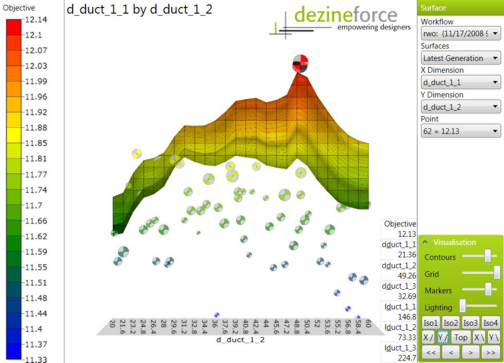Latest News
March 7, 2012
In 2008, a UK-based company named Dezineforce came online to offer simulation over the web. The business model seemed like a promising one. You upload a model, you select the type of simulation you want to run, and you pay for usage. By delivering simulation as Salesforce.com-style SaaS, Dezineforce was giving small and midsize firms a chance to explore design-optimization technologies that they would not otherwise be able to deploy, I thought. (See my previous blog post, “Web-Hosted Engineering Analysis,” May 2009.)
But last week, when I attempted to contact the company for an update, I discovered the website (http://www.dezineforce.com) was no longer active. I tried to locate a PR agency that represented the company, but to no avail. I reached out to the company’s Twitter account (@Dezineforce), but no response came. In the absence of official statements, I sent a few general inquiries out to my Twitter followers and Facebook fans to see if anybody might be able to shed some light. I’m still in the dark.
But on the web, here and there, you can still spot the ghosts of Dezineforce. The company’s business profile page on LinkedIn remains active, but offers no easy way to reach the two employees listed (a director and a marketing support rep). Crunchbase also keeps a profile page on Dezineforce, without any mention of its current state.
On Companycheck, a website for verifying businesses based in the UK, a company called Dezineforce was listed as “Dissolved,” but there was no way to tell if that was, indeed, the company that once occupied the domain dezineforce.com. Evidence does suggest they’re the same. The dissolved company listed on Companycheck was once registered to an address in Eastleigh, Southampton, UK—the same location from where Dezineforce once issued its press releases.
In its early days, Dezineforce was a rising force. It was named Startup of the Day by BizSpark in December 2009.
A press release from Dezineforce in March 2009 struck a promising note, announcing the completion of a “$2.5 M (£1.8 M) Funding for Web Based Engineering.” Dr. Peter Collins, the company’s CEO at the time, said, “IQ Capital Partners, DN Capital, Steve Garnett [that’s the chairman of Salesforce.com] and all of our current shareholders have shown strong confidence in our ability to grow Dezineforce and realize its huge potential to change the face of engineering design. Our on-demand SaaS model enables us to reach a global customer base of small and large engineering companies alike, providing high quality services and enabling organizations both in the UK and abroad to access technology with an ease and at a cost-level never before experienced.”
By September 2009, there were some signs of upheaval within the company. Collins stepped down to become commercial director. He was replaced by George Shanks, who cofounded Rubus, an Internet consultancy. In the next year, Dezineforce, which once pioneered SaaS simulation, began promoting a hardware-software bundle, called HPC Appliance. (Read my previous blog post, “HPC in a Box,” May 2010.)
Afterward, in October 2010, the company raised another $1.57 M (£1 M) from lead investors and new investors—quite possible a lifeline that kept it going for a few more months.
In January 2011, when Director magazine published its list of “20 to Watch in 2011,” it named Dezineforce as one of them. Why was it so special? The magazine noted, “Dezineforce helps smaller engineering firms compete with the big boys.” It also named CEO George Shanks as a rising star.
Dezineforce’s official Twitter account, @Dezineforce, tweeted one last time in February 2011, before it went silent. Former CEO Collins found a new post at Permasense, which specializes in corrosion monitoring solutions.
On-demand simulation, or FEA delivered over the web, still remains an attractive proposition for smaller businesses that cannot afford to invest in dedicated hardware. Companies like Autodesk have begun incorporating web-based design optimization functions to its CAD design packages. Others like ANSYS, CD-Adapco, and Altair Engineering are also exploring a viable licensing model to deliver simulation over the web.
(Note: If you have insights into the last days of Dezineforce, or if you are a former customer, please get in touch with me. I’d like to be able to offer a proper update on the company that took a chance on what I believe to be a good concept.)
Subscribe to our FREE magazine, FREE email newsletters or both!
Latest News
About the Author
Kenneth Wong is Digital Engineering’s resident blogger and senior editor. Email him at [email protected] or share your thoughts on this article at digitaleng.news/facebook.
Follow DERelated Topics







